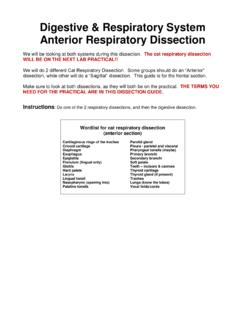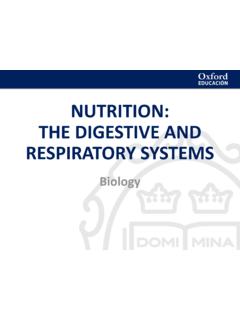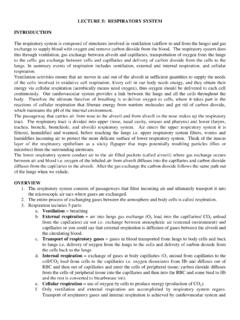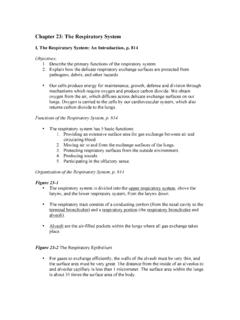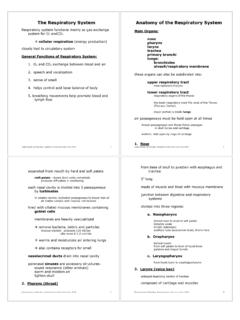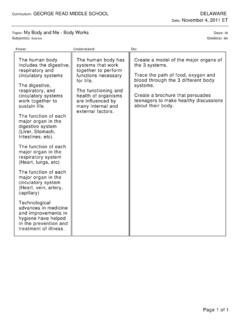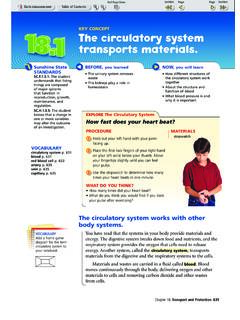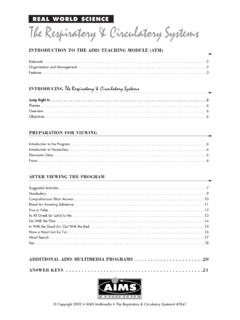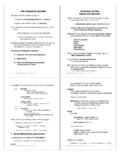Transcription of 1. Epithelial linings of the digestive tract, respiratory ...
1 1. Epithelial linings of the digestive tract , respiratory tract , urinary bladder , and urethra all form from the _____layer of the gastrula. A) ectoderm B) mesoderm C) endoderm D) chorionic villi 2. The portion of the placenta contributed by the embryo is the _____. A) chorion B) allantois C) amnion D) yolk sac 3. Which structure diverts some blood away from the lungs and into the systemic circulation? A) fossa ovalis B) ductus arteriosus C) ductus venosus D) ligamentum arteriosum 4 Which of these substances is/are not teratogenic? A) viruses B) certain drugs C) most water-soluble vitamins D) certain fat-soluble vitamins ALSO: be able to define a teratogen 5. What is the major distinguishing factor that separates the embryonic stage from the fetal stage? A) All major organ systems form during the embryonic stage; the fetal stage consists mainly of rapid growth. B) The brain forms late in the fetal stage; all other organ systems form earlier.
2 C) The skeletal system is laid down during the fetal stage, otherwise organ systems form during the embryonic stage. D) The major event of the embryonic stage is implantation in the uterus; all development occurs during the fetal stage. 6. Which vessel transports blood rich in oxygen and nutrients to the fetus? A) ductus venosus B) umbilical vein C) umbilical artery D) ductus arteriosus 7. Within the fetus, much of the circulating blood bypasses the lungs and flows through the _____. A) ductus venosus B) umbilical vein C) umbilical artery D) ductus arteriosus 8. The period immediately after birth to four weeks of age is called the _____ period. A) senescent B) adolescent C) neonatal D) infancy 9. The period immediately after fertilization, continuing until birth, is called the _____ period. A) senescent B) gestation C) fetal D) developmental ALSO: how long does this period last (normally) in women?
3 11. Many changes occur in the newborn infant as it adapts to a life apart from its mother. What happens to the umbilical vein? A) It continues to transport blood from the navel to the vena cava. B) It closes off to become the ligamentum teres. C) It closes off to become the superior vesical artery. D) It becomes the ligamentum arteriosum. 12, In which menstrual cycle phase does implantation occur? A) menses B) ovulation C) proliferative D) secretory 13. What normally prevents the expulsion of an embryo by a menstrual flow? A) the enzymes around the embryo B) HCG. C) the thickness of the endometrium D) FSH. 15. The structure which implants in the endometrium is correctly termed a _____. A) embryo B) blastocyst C) morula D) zygote 16. When can the term fetus be correctly used? A) at three weeks B) at 12 weeks C) when body systems become completed D) when organs become distinguishable 17.
4 Which extraembryonic membrane is closest to the embryo? A) allantois B) yolk sac C) chorion D) amnion 18. What is the origin of red blood cells? A) yolk sac B) chorion C) fetal bone marrow D) amnion 19. Which membrane plays the greatest role in nutrient and wastes exchanges? A) amnion B) chorion C) allantois D) yolk sac 20. What is the most significant source of estrogens in a eight month fetus? A) ovarian follicles B) pituitary C) corpus luteum D) placenta 21. Which hormone prevents a second pregnancy during gestation? A) FSH. B) LH. C) progesterone D) HCG. 23. In which process do the cells remain the same size? A) differentiation B) cleavage C) growth D) morphogenesis 26. Which is the first system to become visibly most completely differentiated? A) circulatory B) excretory C) nervous D) integumentary 27. When is it first possible to distinguish the sex of a fetus? A) one month B) second month C) third month D) fourth month What event usually occurs about 6-7 days after ovulation?
5 A) Implantation Fertilization Block to polyspermy Zygote formation Damage to the uterine tubes may cause the pre-embryo to implant in a site other than the uterus. This occurrence is called an ectopic pregnancy. a hyadatic pregnancy. an amniotic pregnancy. a uterine pregnancy. What hormone induces labor, increases the force of contractions during labor, and causes milk "letdown"? Prolactin B) Oxytocin hCG. Estrogen ADH. The correct order of the three stages of labor are: expulsion - dilation placental. dilation - placental-expulsion. placental - dilation expulsion. D) dilation - expulsion placental. Where does capacitation take place? ductus deferens. ejaculatory duct. female reproductive tract . seminiferous tubules. ALSO: know what capacitation is, be able to define it. What is responsible for maintaining the corpus luteum during the first two months of pregnancy? hCG (human chorionic gonadotropin).
6 Progesterone Estrogen Relaxin FSH. Which of the following is not a function of the placenta? Provide nutrients Remove waste products Move the blood Provide oxygen Remove carbon dioxide Which fetal vessel contains the highest concentration of oxygen? Umbilical artery Umbilical vein Aorta Inferior vena cava Pulmonary vein Which of the following is FALSE? A) Gestation refers to the period during which the fetal reproductive structures are formed B) Teratogens are substances that show up in mother's milk. C) The decidua capitum of the endometrium is part of the mother's contribution to the placenta. D) Very little fetal blood is sent to the respiratory tract . E) all of tha above are false Put the following stages of the Milk Letdown Reflex in order: 1. Receptors in nipple are stimulated. 2. Stimulation of hypothalamic nuclei 3. Myoepithelial cells of breast contract 4. Oxytocin is released by the posterior pituitary 5.
7 Milk is ejected. Structure whose function is to surround and cushion the developing embryo: A) Chorion. B) Allantois. C) Yolk sac. D) Amnion. Define the following: 1. Leads to the formation of the zygote. 2. Process by which the fertilized egg splits several times, leading to the development of a morula. 3. The process by which a haploid egg is formed from a gamette. 4. Embedding of the blastula in the uterine wall. 5. The process by which the 3 germ layers are formed. Sperm are destroyed by an enzyme produced by a fertilized zygote in what is known as: A) the cortical reaction. B) lysis. C) meiosis. D) enzymatic sloughing. It is impossible for sperm to be functional (to be able to fertilize the egg) until after: A) they have been stored in the uterus for several days. B) the tail disappears. C) they undergo capacitation. D) they become spermatids. Human gestation lasts _____. A) 280 days.
8 C) 270 days. B) 9 months D) 6 weeks Which of the following is false regarding the placenta and placentation? A) The process of placentation begins within the fallopian tubes. B) `The placenta begins to form immediately after fertilization occurs. C) The decidua basalis of the endometrium is part of the mother's contribution to the placenta. D) The placenta is derived from the allantois of the fetus. E) all of the above are false. Which of the following is not a embryonic germ layer? A) ectoderm C) epiderm B) mesoderm D) endoderm Place these in correct sequence after fertilization occurs: 1. Blastocyst 2. Embryo 3. Morula 4. Fetus 5. Zygote Which of the following occurs during meiosis? A) The chromosome number is doubled. B) A gamete is formed. C) A zygote is formed. D) A & C are correct. E) None of the above are correct.
